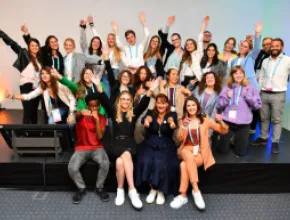One thing is clear about the meetings industry: The avenues available for someone to become a meeting professional are as diverse now as they were 20 years ago.
In the late 1970s and early 1980s, it was uncommon to see a job posting for a “Meeting Planner” or “Event Planner” within a corporation or association. The posting might be for a secretarial or marketing position that included planning meetings and events as part of the job responsibilities.
That was the case for Gloria Nelson, CSEP, chief experience officer of Winneconne, Wis.-based Gloria Nelson Event Design, LLC.
“I, too, started out as an ‘executive secretary’—that was before ‘administrative assistant’ became daily nomenclature—and we had the school of hard knocks,” Nelson says. “The industry wasn’t a recognized profession at that time, and it [meeting planning] was an adjunct to our regular secretarial responsibilities.”
Mary Doherty, who is now the director of education for The Carolinas Center for Hospice and End of Life Care in Cary, N.C., began as an administrative assistant. In 1979, she was working for the Department of Culture and History at the state theater in Charleston, W.Va. When her supervisor took a position in another state, Doherty was lucky enough to move into her boss’ role as events coordinator.
In the case of Sandy Biback, CMP, CMM, founder of Toronto-based Imagination + Meeting Planners Inc., her first position that included meeting planning occurred when she was an office manager.
“During some brainstorming, we decided to add small seminars to our consulting services,” Biback says. “Since I was the office manager, it just seemed a natural progression for me to take it on. By the time I left, I gave up the office management and had a staff of three.”
As her responsibilities changed, her job title changed as well, and Biback became the conference coordinator.
Not everyone started out in a secretarial capacity. For Harvey Paul Davidson, CHME, CME Emeritus, chairman of Westfield, N.J.’s Ad Hoc Committee, his path started in the late 1960s in a marketing capacity. He was hired by 3M’s Visual Products division to do market research on how businesses conducted meetings. This position eventually led to his being hired in 1971 by Price Waterhouse & Co. (now PricewaterhouseCoopers) as a full-time conference and meeting coordinator. In 1980, he took a position at Newsweek magazine as a manager of corporate events, and later became its director of special events.
Joan Eisenstodt was fortunate because she actually had the opportunity in 1978 to work for an association in Washington, D.C., as its first meeting planner. In 1979, she also began consulting—when the association did not have money to pay her—and then officially opened her own company in June 1981.
Similar to Eisentodt, Candy Adams, CTSM, CME, CEM, CMP, CMM, a Chula Vista, Calif.-based trade show consultant, started out working for other companies (in her case, managing corporate exhibits), and has been running her own consulting company since 2001.
“My career in meeting planning began in a somewhat unusual way,” she says. “When I graduated from college in 1979, my senior thesis was a video documentary about a battered women’s shelter in [California’s] Marin County. The executive director of the organization was in the midst of seeking funding for a public affairs coordinator and asked if I would be interested in the position. I jumped at the opportunity and, similar to Nelson, learned about coordinating seminars and trainings through the ‘school of hard knocks.’ My biggest achievement was co-managing the first conference in California on battered women offered to mental health and law enforcement professionals. I had no idea that I had entered the field of meeting planning. All I knew was that I enjoyed coordinating meetings and began seeking positions that included these responsibilities.”
How the Job Market Changed
Twenty years ago, the field of meeting planning was still a ‘learn as you go’ process. The first certification offered was in 1960: the Certified Association Executive (CAE). Around the mid 1970s, a number of other certifications began appearing, such as Certified Hospitality Marketing Executive (CHME), in 1974, and Certified Exhibition Manager (CEM), in 1975. It was not until 1985 that a designation was offered for meeting planners, the Certified Meeting Professional (CMP), and then 10 years later, the Certified Meeting Manager (CMM).
It is only in the past 10 to 15 years that colleges and universities have begun offering degree programs in meeting planning. These certifications and degree programs have helped change the perception of meeting planners as being real professionals.
“More and more, we’re seeing the industry job posts indicate not just the underpinning of education, but also certification designations that show true proficiency within specific areas of expertise,” says Gloria Nelson, CSEP.
Sandy Biback, CMP, CMM, agrees.
“Now, they [meeting planning jobs] are much more frequent and many are looking for education in the area, a CMP [designation], etc. Twenty years ago, it could be anyone.”
Although not all jobs require certifications, an increasing number of job postings state that a certification is preferred under education requirements.
“I believe that the certification of meeting planners is one of the key things that have changed the image of us as professionals versus party planners,” Doherty says. “I’m not sure that it has had anything to do with the public knowing more about meeting planners, but I think it gave meeting planners the confidence in ourselves and our profession to realize that we are professionals. How we perceive ourselves is the most important part of how we are perceived by others.”
When asked what things in particular have occurred in the past 20 years to help transform the perception about meeting planners, the general consensus is that it is due in part, as Davidson says, to “the recognition of meeting planning as a profession by the government and the professional certification programs now in effect.”
Certifications certainly help to validate the profession, but as Biback says, it has to do with “people wanting to enter the profession instead of falling into it….the complexity of meetings has created the need for a professional as opposed to an ‘anyone can do it’ attitude.”
The Next Step for Veterans
For some, the next step is moving more into the academic field, facilitating and training, as has happened with Biback and Eisenstodt.
“As a seasoned planner, I’ve moved much more into the academic field, and facilitating and working with clients to improve what they are doing, being more—I hate the word—strategic,” Biback says. “Having them look before they leap so they know how they will benefit from leaping. I also believe all seasoned planners owe it to the profession to give back by mentoring, etc.”
Eisenstodt also takes her job as a mentor to heart.
“I’ve already moved in the direction that is good for me—as a trainer and facilitator, as a consultant on issues that incorporate the best of what we know,” she says. “Each of us has to find a niche—whether it’s internal or external—and work toward it.”
She also recommends reading books to help people figure out their niche. Three books in particular Eisenstodt recommends are A Whole New Mind by Daniel Pink, Now Discover Your Strengths by Marcus Buckingham, and a digital document titled Hospitality 2010 by Marvin Cetron.
For Doherty, the next step is to sit for the CAE exam.
Situations such as 9/11 and the bird flu epidemic have caused us to be more vigilant about security and health-related issues for our attendees.
The debacle of Enron has forever changed the way that corporations are held accountable with the introduction of the Sarbanes-Oxley Act and companies more focused on return on investment (ROI).
These and other economic and global affairs continually reshape how we plan meetings, events and trade shows, just as the introduction of fax machines, voicemail and Treos have changed the way we communicate with each other.
The opportunities are endless, and 25 years later, I am glad that I accidentally stepped into this field.





